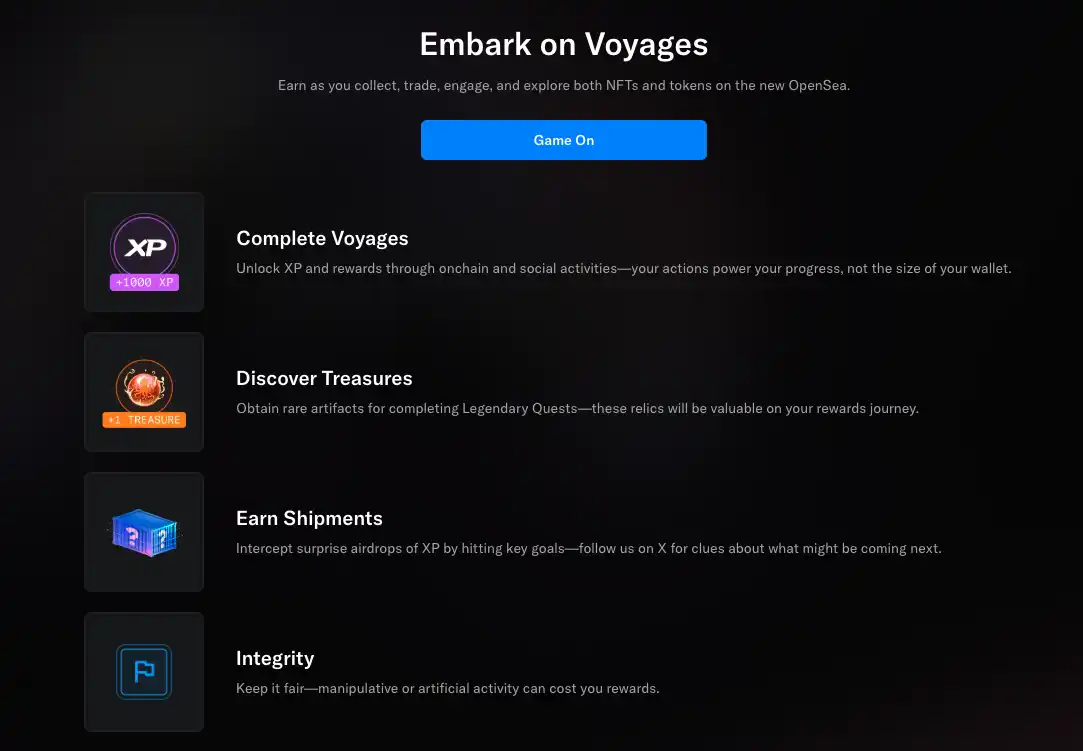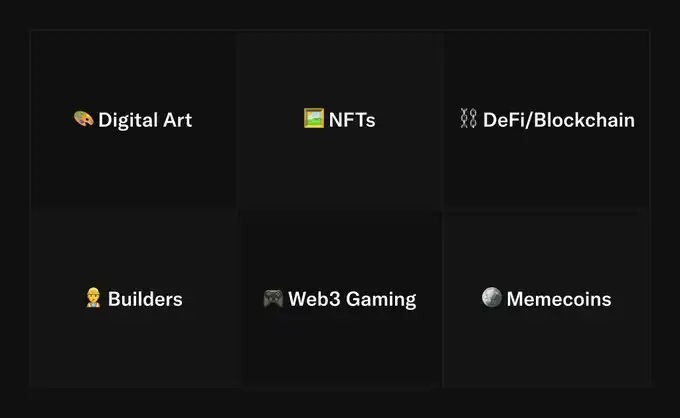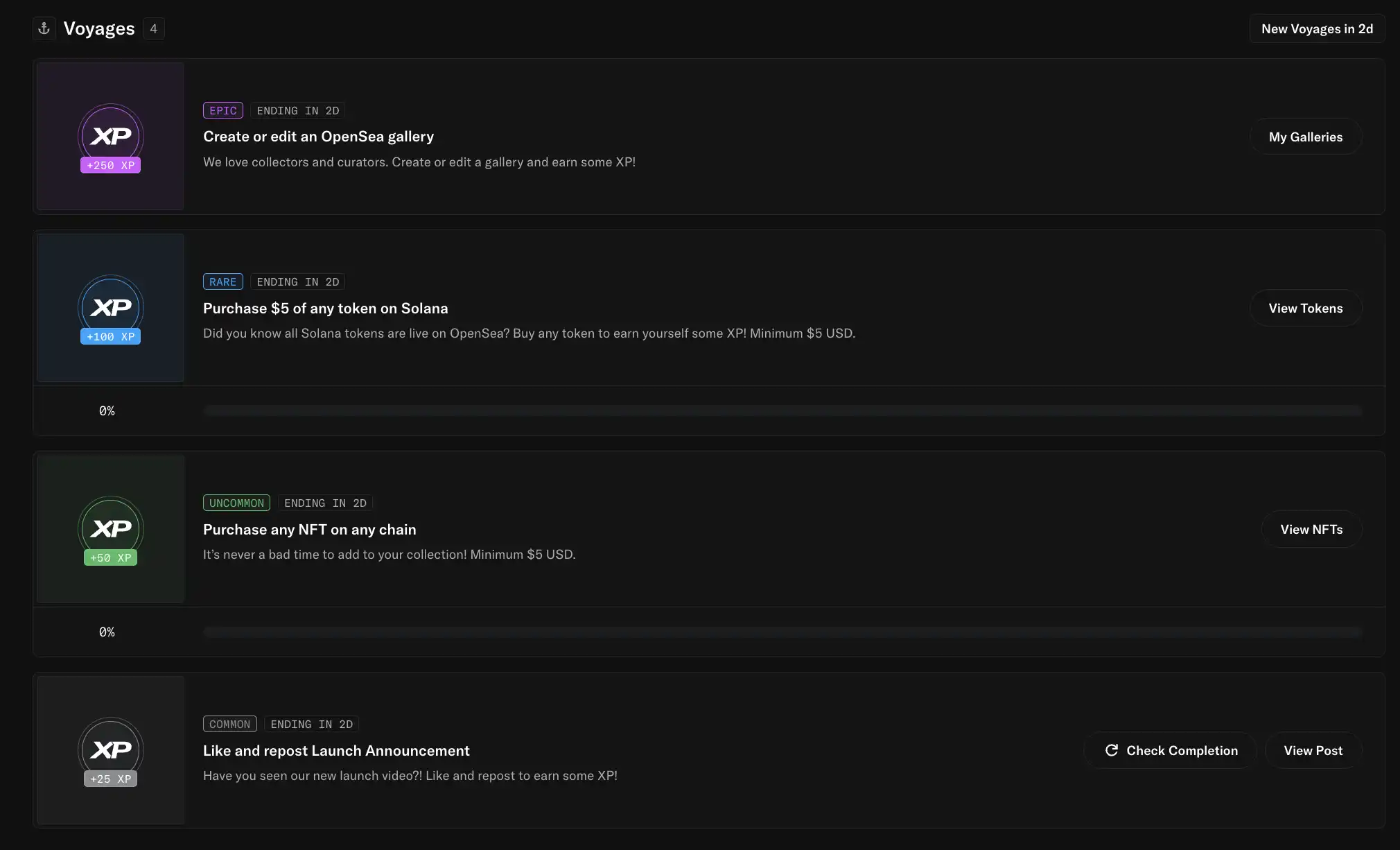OpenSea is about to launch its token, which may be your last but most promising opportunity to participate in an airdrop. Last night, OpenSea announced the official launch of its upgraded platform OS2, marking the countdown to the issuance of the $SEA token. The official statement has clarified that future airdrops will be based on users' historical contributions, current on-chain behavior, and XP points from the Voyages task system.
This article will help you quickly grasp how to complete the latest task updates from OpenSea, covering basic operations such as gallery creation, cross-chain trading, and NFT purchases, while analyzing the incentive logic behind $SEA and the motivations for the platform's transformation.
Transforming into Crypto Asset Trading and Launching a Token Incentive Program
On May 30, OpenSea officially ended its internal testing phase and publicly launched its newly upgraded platform—OpenSea 2 (OS2), marking a key step for this veteran NFT trading market towards transforming into a broader crypto asset ecosystem. The new platform currently supports token trading on 19 blockchains, covering functions from NFT minting to cross-chain token exchanges, and simultaneously launching a user incentive system called "Voyages."

OpenSea co-founder and CEO Devin Finzer stated in the announcement that OS2 is not just a simple iteration, but the "technical and experiential foundation of the next generation of OpenSea." Finzer pointed out that the new platform aims to create a comprehensive trading platform that spans multiple chains and serves different communities, no longer limited to NFT trading but fully embracing various forms of on-chain assets, including standard tokens.
As an important part of this upgrade, OpenSea has also introduced a new user incentive mechanism. Users will earn XP (experience points) by completing operations on the platform such as creating NFT showcase pages, cross-chain trading, and bulk purchases. These points will later be redeemable for OpenSea's upcoming native token—$SEA.

Related Reading: "OpenSea's Seven-Year Journey: The Former 'King' of NFT Exchanges Chooses to Issue a Token"
According to OpenSea's Chief Marketing Officer Adam Hollander, the $SEA airdrop will officially launch through a TGE (Token Generation Event) after a series of key product releases. Hollander candidly stated in a blog post: "We fully understand the community's expectations for the $SEA airdrop, but this is not an ordinary token issuance; it is a core event that will determine the next phase of OpenSea's ecological mechanism."
Currently, OpenSea has not announced a specific timeline for the TGE, but it has clarified that three types of behavior will affect users' airdrop weight:
Historical contributions, i.e., users' past trading activity on OpenSea;
Current behavior, including real usage on the new platform, especially activities related to token trading;
XP points obtained through the Voyages task system.
It is worth noting that "Voyages" is not just a simple task-checking mechanism but is divided into a reward system with five rarity levels (Common, Uncommon, Rare, Epic, Legendary). Some advanced tasks will also unlock special reward items called "Treasures," which will be directly recorded on users' profile pages as proof of their participation and contributions.
Additionally, OpenSea has also restructured its Discord community to make it a hub for Web3 user communication and feedback. According to the official introduction, community channels have been significantly streamlined, and mechanisms such as identity grouping, thematic interviews, and real-time voice interactions have been introduced to enhance user engagement and governance participation.

OpenSea stated that OS2 is just the first step in the platform's transformation, and it will continue to expand supported chains, introduce more asset categories, and promote the deep integration of user incentives, community governance, and platform economic models while ensuring decentralization principles. In Devin Finzer's view, the launch of $SEA is not only a mechanism leap for OpenSea itself but may also become an important watershed for Web3 applications transitioning from a single scenario to a diversified economic system.
Interactive Tutorial
Before the official launch of the SEA token TGE, OpenSea is actively encouraging users to deeply experience its new platform OS2 through a series of interactive tasks. Starting from May 30, the official has launched a new round of Voyages activities, where users can earn XP points by completing on-chain interaction tasks and accumulate qualifications for future redemption of $SEA. This is also seen as a core entry point for participation before the TGE, especially in the context of Blur's history of incentivizing large-scale airdrops through trading behavior, leading to high community expectations for OpenSea's current round of rewards.

The task process in this update is relatively simple and suitable for all users to quickly get started:
Task 1: Create a Personal Gallery
After entering OpenSea OS2, users can create their own NFT showcase page through the "Gallery" feature. Simply upload collectibles and edit the introduction to complete this task, which is a basic step to accumulate XP.
Task 2: Conduct On-Chain Token Trading
Complete a token exchange operation of no less than $5 on the Solana chain (e.g., exchanging SOL for USDC). The transaction fee is very low, about $0.1, which helps familiarize users with the cross-chain trading experience of OS2.
Task 3: Purchase an NFT Priced Around $5
Select any NFT with good liquidity and small price fluctuations for purchase, and it is also recommended to complete this on the Solana chain for low cost and high efficiency.
Task 4: Social Interaction
Complete the official designated tasks of liking and sharing content as required by the event, which helps to enhance community engagement.
It is worth mentioning that OpenSea initially charged account opening fees and has carried countless users' emotional memories of entering Web3. In light of Blur's aggressive airdrop strategy that captured the market, this round of $SEA distribution is seen as OpenSea's "redemption" back to the community. As the activities continue to update, community users have expressed their intention to create tutorials and share strategies around each round of tasks, positioning themselves as potential winners of this round of airdrops.
The Rise and Fall of OpenSea
After announcing the official launch of OS2 and the imminent start of the token airdrop mechanism, OpenSea has once again returned to the spotlight of the crypto world. However, to understand why this once $13.3 billion valued NFT market creator needs such a comprehensive self-restructuring, it is worthwhile to review its ups and downs over the past seven years.
Related Reading: "Success and Failure of NFTs: The Rise and Fall of OpenSea Through the Eyes of 18 Internal Employees"
The story of OpenSea began in the early days of blockchain in 2017. At that time, founders Devin Finzer and Alex Atallah were exploring the idea of sharing Wi-Fi through cryptocurrency until the explosive popularity of CryptoKitties prompted them to rethink the potential of NFTs. In early 2018, the two officially founded OpenSea and successfully secured their first round of funding after joining Y Combinator. At that time, the NFT market was still in its infancy, and OpenSea was once on par with competitors like Rare Bits.
The early days of OpenSea were not easy. Before 2020, its platform trading volume remained at the million-dollar level for years, relying on a lean team and focused strategy to maintain operations. It wasn't until the NFT bull market arrived in 2021 that OpenSea experienced explosive growth. That year, Beeple's digital artwork sold for a record $69 million, and series like Bored Ape Yacht Club (BAYC) ignited market sentiment, with OpenSea's monthly trading volume surpassing $3 billion in the summer and reaching a historic high of $5 billion in a single month by the end of the year.
OpenSea then stepped into the spotlight. In 2021, a16z led a $100 million funding round that pushed its valuation to $1.5 billion. In early 2022, a new funding round further raised its valuation to $13.3 billion, making it the undisputed absolute leader in the NFT market.
However, this was followed by a market downturn and management challenges. On one hand, the popularity of NFTs plummeted sharply from early 2022, while on the other hand, OpenSea faced a series of negative news, including insider trading, outages, and user security incidents, severely damaging its reputation. More importantly, after Blur emerged at the end of 2022, OpenSea's market share among professional traders was rapidly eroded. The new platform launched a "vampire attack" on OpenSea using lower fees, faster execution, and token incentives.
Starting in 2023, OpenSea began a series of layoffs and restructuring efforts to alleviate cost pressures and reorganize its product roadmap, during which its market share had dropped from a peak of 95% to less than 30%. The planned IPO was also stalled due to community sentiment and regulatory pressures. Finzer ultimately decided to completely abandon the "traditional tech company" path and return to the roots of Web3—issuing a token.
Once this news was announced, OpenSea's platform trading volume saw a significant surge, but with the controversy surrounding the airdrop mechanism, the enthusiasm for interaction brought about by the token issuance quickly cooled.

The launch of the SEA token is not just OpenSea's "self-rescue"; it signifies the platform's choice to rebind with users after experiencing repeated pulls between commercialization paths and community trust. The success or failure of this radical strategic restructuring will determine whether OpenSea can rise again from its silence and reshape the competitive landscape of the entire NFT market in the future.
免责声明:本文章仅代表作者个人观点,不代表本平台的立场和观点。本文章仅供信息分享,不构成对任何人的任何投资建议。用户与作者之间的任何争议,与本平台无关。如网页中刊载的文章或图片涉及侵权,请提供相关的权利证明和身份证明发送邮件到support@aicoin.com,本平台相关工作人员将会进行核查。




